- Bernard Preston homepage
- Starch
- Planting Sweet Potatoes
Planting Sweet Potatoes
Planting sweet potatoes could not be easier.
However, to keep the weevil at bay you either have to use strong poisons, or keep hens. This is one crop that your chickens will not rout either.

This page was last updated by Dr Bernard Preston on 10th March, 2021.
Really, it is very easy; the preparation of the ground is not dissimilar to ordinary spuds.
They are heavy feeders and need plenty of well rotted humus. You can either dig trenches and fill them with decomposed leaves, stalks and sticks or, if you have been making a compost pile and have plenty, then you can simply broadcast it.
Dig it in well, and add some lime. Then heap up the rows, about 3 feet, roughly one metre, apart just as you would for ordinary potatoes.
- Bernard Preston homepage
- Starch
- Planting Sweet Potatoes
Now you need a friend who can show you how to grow sweet potatoes. From their bed, look for some heathy slips like these. Using a pair of secateurs, snip off as many runners as he will let you have.
Look for sweet potato slips with little roots already growing. They will take more easily, but really, relax; how to grow sweet potatoes is a breeze. Theyare like weeds.
Can you see the so called adventitious roots?
Planting Sweet Potatoes
How the sweet potato slips look after two months.
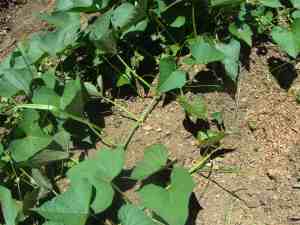
Sweet Potato Slips
Using a pair of secateurs, snip off as many runners as he will let you have; roughly 30cm lengths.
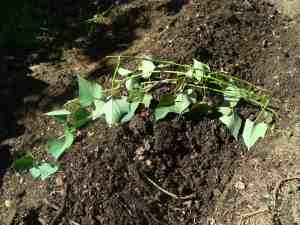
Run your trowel through the hilled row making a small furrow, burying your sweet potato slips, and covering as much of them as you can to reduce transpiration.
Plant two nodes below ground with the axillary bud facing upwards.
I have in fact covered them even more, after taking this picture. Just a few little tips sticking out.
Water them thoroughly.
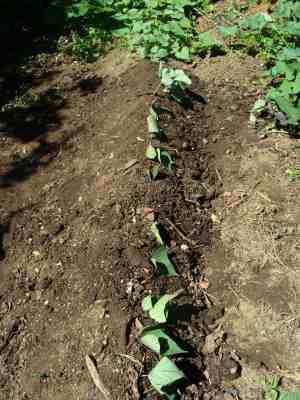
How to grow Sweet Potatoes
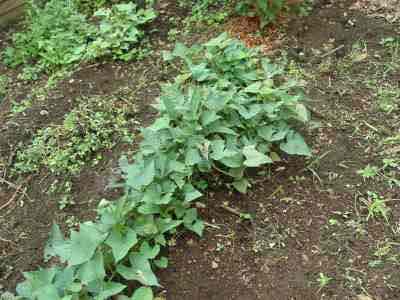
When planting sweet potatoes, cover all the runners and most of the leaves.
Voilà; a month later and you have sweet potato plants. See, growing them is not difficult.
And now what is needed is a bit of patience. You will have to weed them a few times in the first few weeks after burying the runners, but very soon the they will be shading out all the opposition. Planting sweet potatoes is a good deal easier than many other veggies that have continually to be tended.
Many brightly coloured varieties
As always choose the brightly coloured foods; they are richer in the phytosterols that prevent cancer. They are tastier in any case. Each have their own particular virtue.
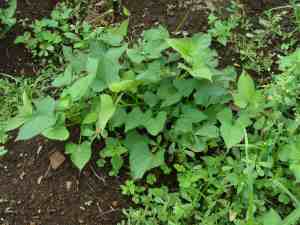
Sweet potato ground cover
One of the joys of planting sweet potatoes is that they form a perfect ground cover. Within six weeks runners from the main sweet potato slips wil have filled the the gaps between the rows. Need a ground cover?
Think no further than how to grow sweet potatoes! Very few weeds can compete with the sweet potato ground cover.
Even the butternut are having to compete, but they will survive with their broad wide leaves. I'm more concerned about the Pepperdews, and Helen has made threatening noise if they get into her Queen Elizabeth.
I am one of the lucky doctors who has fresh flowers every day in the clinic, and for most of the year it is roses.
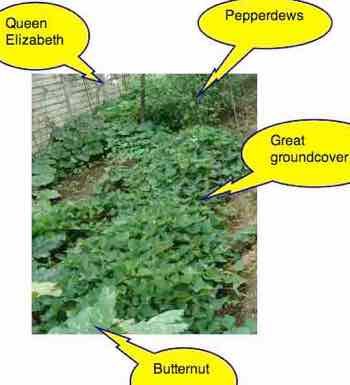
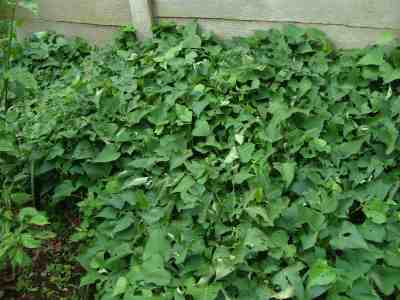
Harvesting sweet potatoes
About three months after planting sweet potatoes they will start to flower. Note the date on the calendar; roughly a month later you can start harvesting them.
Meantime, this page is in development. It's now midsummer, and both you and I must be patient for a couple months while nature and sunshine doing their work.
Here's the first update. The patient waiting is over. Yesterday, I planted my fork for the first time and just look what I found; we have months of sweet potatoes ahead. Harvesting sweet potatoes couldn't be easier. I just dug in the fork, lifted some soil and went in search with my fingers. The plant is still alive and I know there are plenty more corms under there.

Frosted sweet potatoes
Perhaps a more reliable way of harvesting sweet potatoes is to wait for the first frost; the leaves will immediately turn black and die off. Leave them for a week for the nutrients in the leaves to be absorbed into the potatoes.
We plant them with butternut, which are in the ascendancy early on, but die back sooner. After the frost you can immediately see the butternut crop.

Calories
A cup of sweet potato (about 100g) contains only 100 calories.
Glycemic Index of sweet potatoes
Surprisingly, unlike most starches, boiled sweet potatoes have a low glycemic index of about 45; below 55 is considered low, which means that the sugars are released slowly into blood stream, and much passes through undigested to the colon where it is eagerly fermented by the microbiota. That's good, not just for diabetics, for example, but any of us who want to shed a few pounds. Research is now showing that it's the high GI carbohydrates, not fat, that generally make us obese.
A double surprise, though, is that roasted and grilled sweet potatoes have a very high glycemic index. They are better boiled.
Sweet potatoes are rich in vitamin A and its precursor beta carotene.
One of the great virtues of sweet potatoes is that they are extremely high not only in vitamin A, and also in E and K; these are the fat soluble vitamins, but what is surprising is that sweet potatoes have virtually zero fat. Vitamin C is quite high, too.
Research shows that adding a little fat to your sweet potatoes increases the absorption of vitamin A. If your cholesterol is in good shape, a lump of butter, otherwise olive oil; or that's one of the avocado benefits. eat them with avocado. Fat also lowers the glycemic index, also making them less digestible in the small intestine, where they would give us a blood glucose surge.
Although they are high in carbs, about 25% by weight, a problem for overweight folk, their great virtue is that the food industry has not (yet) got its fork into them. You cannot buy white sweet potatoes like you can with rice, bread, flour, sugar and there is no speedy mash. It is a full, complex carbohydrate, unspoiled by processing. Good stuff, but to be eaten in moderation by the obese.
Potassium in sweet potatoes
Less than two percent of the folk in the West get enough of the required 4,000 g of potassium per day, which gives 20 percent protection against all forms of death; that is massive.
Potassium lowers blood pressure and is involved in many other processes such as bone strength and muscle mass; hence it is importance in preventing frailty syndrome, the premature loss of vitality.
Planting sweet potatoes means you have substantially enabled your family to get sufficient potassium, at 337 mg per 100 g.
Spinach, squash and legumes are other good sources.
Butternut soup
Sweet potato and butternut soup is a great favourite in our family. Add to it your own wild leeks and you know that it is truly organic.
Since acquiring the hens we have no more problems from the sweet potato weevils that devastated our crop over the last couple years.
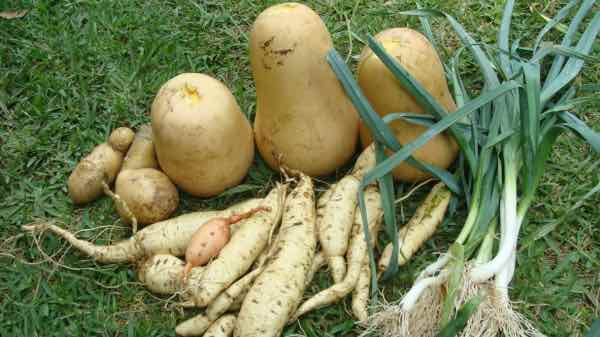
Add either coconut milk or dairy cream to make a memorable meal.

This is without a doubt my favourite tasting soup. It has many virtues, not least that you can prepare it very quickly and the added coconut milk contributes the fat that you need to absorbe the beta-carotene.
Boiling sweet potatoes, compared to roasting or baking which turn them into a high GI food, is the best way keep any possible insulin surge low.
Easy butternut squash soup with sweet potatoes is not rocket science.
Never get limited by a recipe. How about some finely chopped pecan nuts sprinkled over your butternut and sweet potato soup?
Weevils
Sweet potatoes are blighted by a tiny weevil that attacks every root, covering it with ugly black bites. The only solution is to move to a different bed every year, or so my supplier tells me.
There is another solution; get some hens.
I had decided to give up planting sweet potatoes, the blight was so awful, and we refused to poison them in our organic garden. Imagine my astonishment this year when they come up as usual and not a sign of the weevil blight.
Is it a coincidence that six months ago we obtained seven hens and a cockerel? They roam constantly through the sweet potato bed.

What's potting?
Composting is half the secret to a healthy, organic garden. If you have a large garden, and aren't too house proud, the best is simply to make a heap in a less visited corner; it's an urban myth that they smell. Just don't put any cooked food left overs in it; that will rot and attract vermin.
Newsletter
Our newsletter is entitled "create a cyan zone" at your home, preserving both yourself and Mother Earth for future generations; and the family too, of course. We promise not to spam you with daily emails promoting various products. You may get an occasional nudge to buy one of my books.
Here are the back issues.
- Lifestyle and ideal body weight
- What are ultra-processed foods?
- Investing in long-term health
- Diseases from plastic exposure
- Intensive lifestyle management for obesity has limited value
- A world largely devoid of Parkinson's Disease
- The impact of friendly bacteria in the tum on the prevention of cancer
- There's a hole in the bucket
- Everyone is talking about weight loss drugs
- Pull the sweet tooth
- If you suffer from heartburn plant a susu
- Refined maize meal and stunting
- Should agriculture and industry get priority for water and electricity?
- Nature is calling
- Mill your own flour
- Bake your own sourdough bread
- Microplastics from our water
- Alternative types of water storage
- Wear your clothes out
- Comfort foods
- Create a bee-friendly environment
- Go to bed slightly hungry
- Keep bees
- Blue zone folk are religious
- Reduce plastic waste
- Family is important
- What can go in compost?
- Grow broad beans for longevity
- Harvest and store sunshine
- Blue zone exercise
- Harvest and store your rainwater
- Create a cyan zone at your home
If you want a spic and span garden then you must spend a lot of money and buy or make a slatted compost heap box. You are very limited by size.
I have about five compost heaps in various states of decay; small, fibrous stuff like leaves and grass cuttings take only three to four months to break down; quite large sticks may take a year or two. Always try to include a couple old, rotting logs. It needs plenty of air for aerobic composting so don't press it down; it will collapse of its own accord as you add more garden and kitchen waste.
At the end of the season, the sweet potato runners are perfect for the compost heap.
Making a compost pile
Making a compost pile for planting sweet potatoes is the solution to any nutrient deficiency.
Knowing what to plant, and when is important. This page is perhaps only relevant to those living in a mild climate like ours. Yesterday, late summer, I planted two kinds of peas and radish...
Did you find this page interesting? How about forwarding it to a friendly book or food junkie? Better still, a social media tick would help.
- Bernard Preston homepage
- Starch
- Planting Sweet Potatoes
Address:
56 Groenekloof Rd,
Hilton, KZN
South Africa
Website:
https://www.bernard-preston.com